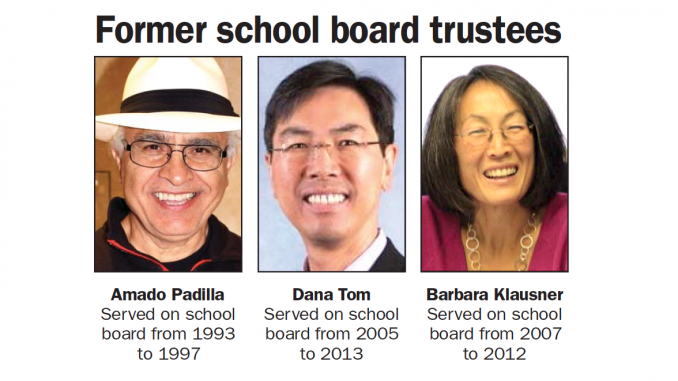
BY ALLISON LEVITSKY
Daily Post Staff Writer
Asians and Latinos are less likely to win seats on the Palo Alto school board because the city is racially polarized, an attorney claims in a letter to the school board that demands a change in the election system.
One possibility would be to replace the current at-large elections with district races, in which voters elect candidates from their section of town. Currently, Palo Alto voters elect five school board members rather than voting in districts.
Alexander Tomescu, an associate attorney at the Laguna Niguel firm Wewer and Lacy, doesn’t say who he is representing in the Aug. 10 letter, but instead urges the board “on behalf of residents within the jurisdiction” to tell him by Sept. 24 whether the district would be willing to change its current at-large system.
Tomescu claims in the letter that Palo Alto school board elections are racially polarized and violate the California Voting Rights Act of 2001.
Unlike the federal Voting Rights Act, the state law doesn’t require that minority groups demonstrate they are large and geographically compact enough to constitute a majority-minority district.
The state Voting Rights Act only requires that a plaintiff show the existence of racially polarized voting to prove that at-large elections are in violation of state law.
Tomescu cites that a Latina school board candidate, Gina Dalma, ran and lost to non-Latinos in 2014 and 2016, and that there are no Latinos or Asians currently on the school board. Latinos represent 7.1% of the city population, he cites, and 12.3% of student enrollment.
In 2016, Srinivasan Subramanian ran but withdrew two months before the election. Tomescu incorrectly states that Subramanian ran and lost to non-Asian candidates.
Asians represent 31% of the city population and 34.8% of students in the district, according to Tomescu.
The school board has had a handful of Asian and Latino school board members in recent decades, including Amado Padilla from 1993 to 1997, Dana Tom from 2005 to 2013 and Barbara Klausner from 2007 to 2012.
School re-naming dispute
Tomescu also points to the racially charged dispute over whether to rename Jordan or Terman middle school after Fred Yamamoto, a Japanese-American Palo Alto High School graduate who shared a name with an unrelated Japanese admiral.
Tomescu incorrectly states that the district renamed a school after Yamamoto. In fact, the board ended up deferring to the dozens of mostly Chinese parents who opposed the name.
The school board discussed it in closed session on Tuesday night and school board trustee Todd Collins asked that it be placed on a future agenda for a public discussion. Collins pointed out that the city of Santa Monica has spent close to $5 million defending itself in court against a Voting Rights Act lawsuit.
‘Diluting minority voters’
Collins said Santa Monica is “not dissimilar” from the Palo Alto school district in that both agencies view themselves as “not having a problem of diluting minority voters.”
Steve Chessin, a Mountain View software engineer and board member of Californians for Electoral Reform, noted the word-for-word similarity between the letter and a letter that Malibu attorney Kevin Shenkman has been sending to public agencies, including the city of Redwood City and Menlo Park.
Menlo Park switched to district elections after receiving a letter from Shenkman.
$30,000 check
He also said it was suspicious that Tomescu hadn’t named a plaintiff and suggested he could be seeking the $30,000 financial award tied to successful Voting Rights Act lawsuits.
“This could be a bluff just to try to extort $30,000,” Chessin told the Post. “He ought to be willing to tell the PAUSD attorney who (the plaintiff) is, subject to an agreement that the attorney will keep that private. Then the attorney can tell PAUSD if there really is a potential plaintiff or not.”
Chessin also recommended that the school district have a discussion with Tomescu, negotiate a written agreement that puts a $30,000 ceiling on any award for a potential lawsuit and hire a demographer to determine if district elections would actually enable Latinos or Asian-Americans to elect a candidate of their choice.
Elections attorney Gautam Dutta, whose office is in Redwood City, said that the state Education Code allows school districts to pursue options other than going to district elections, including ranked-choice voting.
One-size-fits-all approach
Dutta said he thought district elections were more appropriate in segregated cities that have high concentrations of minority groups in particular neighborhoods, which Palo Alto doesn’t seem to have.
“The one-size-fits-all, requiring everybody to go to districts, I do not believe serves the cause of diversity in all instances,” Dutta told the Post.
Other approaches the board may consider are introducing ranked-choice voting, in which voters can rank their preferences rather than only voting for two or three candidates.
That method helps avoid vote splitting. If two Asian candidates ran for one seat on the school board, for example, Asian voters could rank both as their top two. That way, votes for each of the two would be transferred to the other.
Another approach is cumulative voting, which the city of Mission Viejo recently approved. Voters given three votes can give all three to one candidate, or split them up.
One drawback to cumulative voting is it doesn’t solve the vote-splitting problem, Dutta pointed out.



The bigger issue is that people keep electing Ivy League graduates. We need de-stressing, not more academic stress. Please don’t blindly vote for the Ivy League graduates because they favor more rigor and will do nothing to decrease stress. Dauber is the only exception (Brown) who favors less rigor.
How would one draw these districts? Is there a section of the city dominated by Latinos? Or Asians? I really don’t think Palo Alto is segregated that way. If this out-of-town lawyer sees a problem, it would be helpful to hear a solution that solves the problem.
Less academic rigor in Palo Alto, ain’t gonna happen. If you want less academic pressure on your children, then you are in charge of that. Parents set expectations much more than teachers or a school district.
Less rigor = dumbing down
Abby & KW: You obviously have not experienced AP classes in PAUSD high schools or have top 1% students. Less rigor doesn’t mean dumbing-down, that’s ignorant thinking. Parents do not set the expectations. It’s the teachers who control the rigor. Teachers should not be grading on strict curves—if everyone deserves an “A”, they should allow it. Otherwise, only 2-6 per class get “A”s while the others are smart enough to get “A”s in other school districts so only the top percentage can earn “A”s.